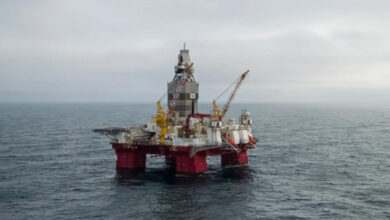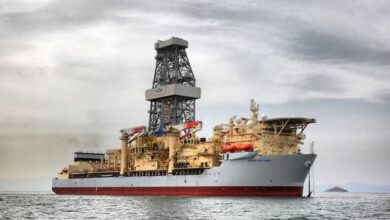Chesapeake, Questar share ways to reduce environmental footprint
Chesapeake Energy and Questar E&P shared innovative tactics to improve environmental performance during a panel session at the 2010 IADC Drilling Onshore Conference & Exhibition, held 20 May in Houston. Chesapeake focused on how the US can shift energy demand from oil to the more clean-burning natural gas, while Questar shared their experience from operating in the environmentally sensitive Pinedale Anticline.
By targeting and transitioning North American heavy-duty trucks, transit busses, refuse trucks, commercial fleets and school busses to compressed natural gas instead of gasoline, the US could gain 12 Tcf/yr of additional gas demand in the next 10-12 years, said Norman Herrera, market development for Chesapeake Energy. This could go toward easing American dependence on foreign oil, he said. “In 2009, the US imported 4.3 billion bbl of oil at a cost of a quarter of a trillion dollars,” he said. This represented two-thirds of US oil needs, and 70% was used to run a 250 million-vehicle fleet of cars, trucks and SUVs.
Mr Herrera noted that there is natural gas production coming out of 32 states in the US, which provides opportunities to talk about transitioning to natural gas-powered vehicles. Due to the explosion in shale gas production – US gas supply has increased 58% in the last four years, and 85% of US gas supply is produced domestically – the US has the resources available to achieve this transition, he said.
As early as this year, the EPA will be implementing new smog standards that could mean compliance costs of $19 billion/yr to $90 billion/yr by 2020, Mr Herrera said. Most of these costs will burden manufacturers, oil refiners and utilities – another reason Mr Herrera believes this transition would be beneficial.
What needs to happen to start this transition?
The first challenge is getting companies like GM, Ford and Chrysler to manufacture the vehicles and make them available to the public. For transportation used within industry, using original equipment manufacturer-approved vehicles can also help the transition. “When you can have a warranty product in year 10, year 11 that runs on compressed natural gas, from the factory, with minor modifications, that means a company has taken a risk and has taken note and seen that there’s a market for this product.”
Once vehicles are produced and in the marketplace, where will people fill-up?
Gaining support from local retailers to invest in natural gas filling stations will provide a source of supply distribution. “The model we’ve seen successful is targeting private retailers and offering a fuel contract that guarantees a minimum number of consumption,” Mr Herrera said.
While Mr Herrera’s presentation focused natural gas-vehicles, Questar addressed environmental impact mitigation in the Pinedale Anticline.
Diana Hoff, general manager of the Pinedale division, Questar, noted that the Pinedale Anticline is home to species like Elk, mule deer, antelopes and bald eagles. The company works closely with the Wyoming Gaming and Fishery Department to maneuver around the sensitive nature of this environment.
Previously, Questar was only allowed to work during specific seasons of the year to protect wildlife habitats in the area. “We have a lot of wildlife that hangs out in Pinedale in the winter, so we need to minimize the area that we are taking up for pads and roads and take traffic out of the area,” Ms Hoff said.
Questar closely monitors all wells and facilities and takes a variety of steps to limit habitat disturbance.
In 2005, the company put in a proposal to the Wyoming Gaming and Fishery Department requesting year-round access to Pinedale, which returned surprising results. The agency said “that it was actually better for wildlife (to operate year round) than operating out of the seasonal stipulations,” Ms Hoff said.
Additionally, with year-round access to the area, Questar was able to cut down their development time from 62 years to 12 years.
Other ways the company has been able to reduce its environmental impact include drilling horizontally on bigger but not as many well pads and using subsurface wells to reduce surface disturbance on the land.
Questar also installed a liquids gathering system that is piped out to the refinery. According to Ms Hoff, this system has reduced tanker truck trips by 85,000/yr. “We pipe the water down to the evaporation bed, and it gets filtered, and it gets piped back up and is used for stimulation,” she said. This system will be deployed throughout the Pinedale field development and could save 165,000 tanker trips/yr.
Emissions were another environmental factor that the company addressed while operating in the area, Ms Hoff said. “There’s a little haze over the mountains. They just don’t seem as clear to me,” she said, quoting community feedback in 2008. In response, Questar began monitoring emissions.
Despite these efforts, in the winter of 2008, the area suffered an ozone spike due to the sun reflecting off snow, or “snow pack.” The ozone increase led the EPA to step in, and in response the state of Wyoming developed a program that requires operators to reduce nitrogen oxide (NOx) emissions by a ratio of 1.1:1 and 1.5:1 for VOCs.
In 2012, Questar will be required to submit a plan on how to get to zero day visibility impact, in order to comply with the requirements laid out by the Bureau of Land Management and the Wyoming Department of Environmental Quality. For the first time, companies will also be required to obtain air permits to resume production.
Despite the company’s proactive approach to environmental protection, local agencies declared that anything completed before 1 April 2008 to help with ozone emissions would not count toward stipulations in new legislation. This negated most of the work that Questar had done to help keep the environment intact. “The agencies told us they wouldn’t implement anything that would penalize early adopters, like Questar, and they really have,” she said. “It’s really a shame that they couldn’t come up with a way to increase incentives for proactive operators because we are certainly getting punished.”




